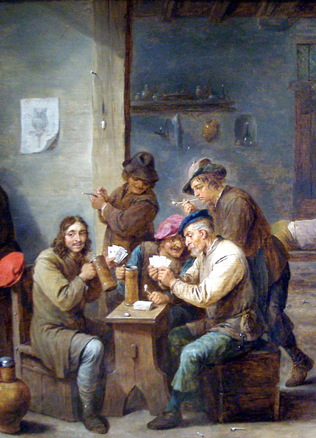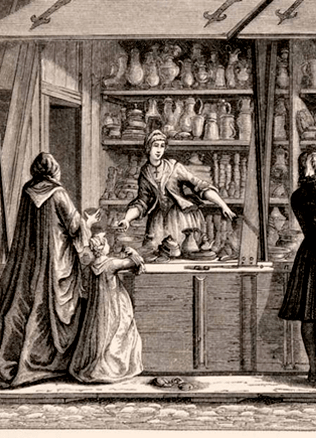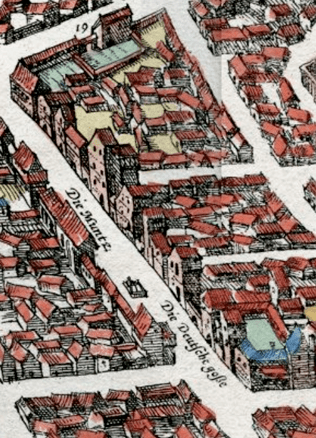Marketplaces and markets
The market, the marketplace is a public place of regular exchanges. According to historians of economy, it was there that the market started and began to develop. Its future always belonged on the vitality of the market, and the latter depended on the consumption possibilities of the community (which did not necessarily have to be settled) that made use of it. The early history of the marketplaces is confusing because they were spontaneously formed in those places where people saw convenient possibilities to exchange the products that they made. However, the marketplace’s establishment in one place was never accidental. It was determined by two most important circumstances: marketplaces were established at the intersection of the exchange routes and the places of accumulation of assets. In the Middle Ages when the roads were bad, power of the dukes who collected duties often changed and the communities of people were small, a network of marketplaces could not be dense and exchanges there could not be lively. Therefore, it is impossible to give an exact answer to the question when the market emerged in Lithuania. In all times people exchanged the products they made. Near the more important centres of the community’s life (castles, places of worship, crossings of important roads, fords, etc.) stable places of exchange could have appeared. We do not know what general name was used for those places. The common Slavonic word for market (torg, торг) stuck to those places not later than at the end of the 14th century. Until the 16th century this word gradually acquired a different meaning.
Do You Know?
The first market place in Vilnius was established in the 14th century in the territory close to the castle where the roads leading to the castle from Trakai, Rūdninkai, Medininkai and Pokantiškės (around the place of the Church of St Johns) intersected. At the end of the 14th century, the market place moved to the place of the current Town Hall Square, to the intersection of the Ruthenian and German quarters. The Town Hall stood already there in the 16th century, and next to it several more market places were founded – horses (south of the Town Hall), fish (close to the Orthodox Church of St Parasceve, north of Town Hall Square), cattle market (beyond the wall, next to Rūdininkai Gate) and the market in the suburb of Lukiškės.
The market is the most important attribute of the town
Places close to a castle where small numbers of craftsmen lived had to be marketplaces in the 13th–14th centuries. The Duke’s agents had to act there too; they ordered products and services of the craftsmen and paid for them with the assets accumulated in the corn bins and warehouses of the castle. Vilnius is a good example of the relations between the marketplace and the castle. In the 14th century, the early market place of Vilnius formed in the territory close to the castle where the roads leading to the castle from Trakai, Rūdninkai, Medininkai and Pokantiškės (around the place of the Church of St Johns) intersected. At the end of the same century, after the quarters of the Ruthenians (to the east towards Užupis, at the eastern end of current Castle Street) and the Germans (currently Germans’ Street) expanded, the market place moved towards the place of the current Town Hall Square. Hence, the place of exchange was determined by the needs of the growing community.
It is difficult to guess whether free exchange could have taken place in marketplaces due to the superiority of the Duke’s powers. At least larger exchanges were controlled by the officials appointed by the Duke then, who taxed the goods being sold in the marketplaces. This exclusive right of the Rulers included taxation of the goods being imported into the country, as well as the right to establish new market places.
The Baptism of Lithuania did not change the situation. True, in 1387, the rulers started granting privileges to the towns, a new mechanism of redistributing incomes derived from the market was planned to be introduced: a part of the income was given to the town. The period of peace and the economic upturn that started in the middle of the 15th century was somewhat more significant to the history of the market. Towns and small towns grew, their network became denser.
The historians understand the hints found in the sources of the 15th century unambiguously as a testimony of existence of markets in those places.
It seems that in all cases, when churches were being founded in rural areas, the possibility to establish legally or spontaneously marketplaces next to them appeared. According to the historians, until the end of the 15th century there were about 50 towns and small towns in the territory of current Lithuania and Belarus, which had marketplaces. There was more than one market in larger towns. Also, the marketplace at the intersection of the Ruthenian and German quarters located there as far back as the 14th century became the main market square in the 15th century. During the first years of the 16th century the Town Hall already stood there. As can be surmised from the hints in the sources, the form of the square was irregular because the city had the shape of the territory spontaneously build up with farmsteads. It was in the middle of the 16th century that the perimeter of the square became regular, and the houses that bordered it were arranged in lines. While the central market square was being put into order several more markets were established close to it – horses (south of the Town Hall), fish (close to the Orthodox Church of St. Parasceve, north of Town Hall Square), cattle market (beyond the wall, next to Rūdininkai Gate) and the markets in the suburb of Lukiškės.
Ruler’s attempts to curb chaotic trade
Market places of small towns most often were established without any plan and control. We do not have much information about them from the 16th century. At that time the network of towns and small towns (at the same time that of market places) was rapidly becoming denser: until 1550 there were about 300 of them in the territory of current Lithuania and Belarus, and at the end of the century this number stood at about 500. It is symptomatic that we have no privileges of establishment of the majority of these towns and small towns. Even in those cases when they are known from the history of the small towns a chaotic nature of their formation becomes clear. Hence, in 1552, the Bishop of Samogitia complained to the ruler that Žarėnai keeper secured the right from the ruler to have a market in his small town, which did harm to the market of the Bishop that had functioned in the town of Medininkai for a long time. The Ruler promised to the Bishop to tear down the town of Žarėnai and to ban the market therein.
The Ruler tried to curb the establishment of marketplaces all the time. The flow of privileges of establishing small towns issued by the Chancery of the Ruler in the 16th century illustrates these attempts. It is thought that the privilege of establishing a small town provided for the possibility of appearance of a market even if it was not so clearly singled out in the privilege. In a legal sense such a market was illegal but the owner was difficult to be control on his own land and nobody could prevent him from legalising the functioning market after a special privileged had been obtained from the ruler.
The tone of establishing private small towns was becoming ever harder in the course of the first half of the 16th century.
If at the beginning of the century the issue of a market in such a privilege could not have been discussed in more detail, later the conditions of its functioning were most often indicated: market days per week, the right to organise fairs alongside a weekly market, the protective zone of the market (prohibition for other owners to establish another market at a certain distance from the existing one), reservations retained by the ruler, which indicated that the right of a market will be granted if it does not do any harm to the functioning markets. Because of the latter reservation the third persons could appeal against the privilege granted and the ruler had the right to cancel it. The essential problem of regulating the market network was not their becoming denser but the activity of geographically close markets on the same days. The councils that had to defend the ruler’s interests did very little there. This is testified to by the decree issued by Sigismund the Old that required that all the owners of the markets should adapt to the schedule of the activity of the market places of Duke Konstanty Ostrogski who had a private network of the towns and small town on their land. Putting the initiative in the hand of his favourite, the ruler encouraged the uncontrolled activity of marketplaces even more.
A glance at the market of the 16th century
Day-to-day life of the market in the first half of the 16th century is known but little. It attracted peasants and the nobility therefore there is no reason to think that only local agricultural products were traded there though the latter prevailed. This situation is dictated not only by natural logic that local manufacturers with their local goods prevailed in the market but also by the regulations of separate marketplaces known to the historians in which market taxes were regulated from dry substances (corn and salt) to cattle. An accidental 1551 register of the income of Pasvalys market that belonged to the local deanery testifies to the fact that market days prevailed regularly (in this case on Thursdays). Not all the market days of small towns were a success. The most active trade was carried out in the months of January and February and from March to June trade almost came to a stop, in the second half of the year it came to life again, but it was not very active. One or two successful market days were followed by an unsuccessful one. This shows that the market was poorly developed: the demand was easily satisfied, the buyers were not very solvent and the markets were almost unspecialised.
Regulating small towns and the activity of the market contributed to the stabilisation of the network of marketplaces and trade carried out therein. In the middle of the 16th century, when the plan of small towns was reorganised according to the volok reform, the form of the majority of the marketplaces became irregular. At that time the most important buildings were arranged in the perimeter of the marketplace: the houses of the Prefect and the Deputy Elder of the village, inns, craftsmen workshops, the church. Even today we see the dominant position that the marketplaces used to have in the majority of old Lithuanian small towns.
Literature: A. Miškinis, Miestų ir miestelių raida nuo XV a. pradžios iki XVI a. vidurio, Lietuvos architektūros istorija, vol. 1, Nuo seniausių laikų iki XVII a. vidurio, Vilnius, 1987, p. 56–67; E. Saviščevas, XVI a. vidurio Lietuvos miestelio rinka: Pasvalys 1551 metais, Kultūrinės atminties kaita ir lokalinė istorija, (Acta humanitarica universitatis Saulensis, Mokslo darbai, vol 9), Šiauliai, 2009, p. 255–264.
Eugenijus Saviščevas



